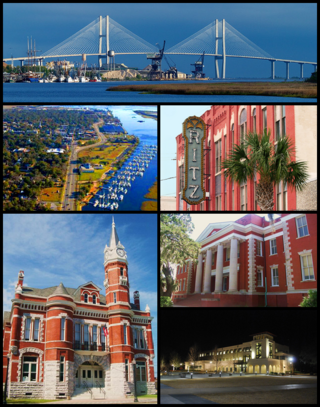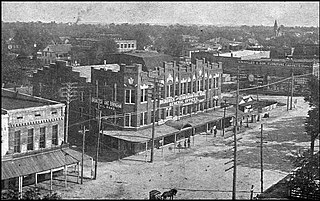
A suspension bridge is a type of bridge in which the deck is hung below suspension cables on vertical suspenders. The first modern examples of this type of bridge were built in the early 1800s. Simple suspension bridges, which lack vertical suspenders, have a long history in many mountainous parts of the world.

Brunswick is a city in and the county seat of Glynn County in the U.S. state of Georgia. As the primary urban and economic center of the lower southeast portion of Georgia, it is the second-largest urban area on the Georgia coastline after Savannah and contains the Brunswick Old Town Historic District. At the 2020 U.S. census, the population of the city proper was 15,210; the Brunswick metropolitan area's population as of 2020 was 113,495.

A cable-stayed bridge has one or more towers, from which cables support the bridge deck. A distinctive feature are the cables or stays, which run directly from the tower to the deck, normally forming a fan-like pattern or a series of parallel lines. This is in contrast to the modern suspension bridge, where the cables supporting the deck are suspended vertically from the main cable, anchored at both ends of the bridge and running between the towers. The cable-stayed bridge is optimal for spans longer than cantilever bridges and shorter than suspension bridges. This is the range within which cantilever bridges would rapidly grow heavier, and suspension bridge cabling would be more costly.

Sidney Clopton Lanier was an American musician, poet and author. He served in the Confederate States Army as a private, worked on a blockade-running ship for which he was imprisoned, taught, worked at a hotel where he gave musical performances, was a church organist, and worked as a lawyer. As a poet he sometimes used dialects. Many of his poems are written in heightened, but often archaic, American English. He became a flautist and sold poems to publications. He eventually became a professor of literature at Johns Hopkins University in Baltimore, and is known for his adaptation of musical meter to poetry. Many schools, other structures and two lakes are named for him, and he became hailed in the South as the "poet of the Confederacy". A 1972 US postage stamp honored him as an "American poet".

The Dames Point Bridge is a cable-stayed bridge over the St. Johns River in Jacksonville, Florida, United States on the Interstate 295 East Beltway. Construction began in 1985 and was completed in 1989. The main span is 1,300 feet (396.2 m), and is 175 feet (53.3 m) high. The bridge was designed by HNTB Corporation and RS&H, Inc. The Massman Construction Company built the bridge.

The Fremont Bridge is a steel tied-arch bridge over the Willamette River located in Portland, Oregon, United States. It carries Interstate 405 and US 30 traffic between downtown and North Portland where it intersects with Interstate 5. It has the longest main span of any bridge in Oregon and is the second longest tied-arch bridge in the world. The bridge was designed by Parsons, Brinckerhoff, Quade and Douglas, and built by Murphy Pacific Corporation.

The BNSF Railway Bridge 5.1, also known as the St. Johns Railroad Bridge or the Willamette River Railroad Bridge, is a through truss railway bridge with a vertical lift that spans the Willamette River in Portland, Oregon, United States. Built by the Spokane, Portland and Seattle Railway (SP&S) and completed in 1908, it was originally a swing-span bridge, and its swing-span section was the longest in the world at the time. However, 81 years later the main span was converted from a swing-type to a vertical-lift type, in order to widen the navigation channel. The lift span is one of the highest and longest in the world. The bridge consists of five sections, with the two sections closest to the bank on each side fixed.

The Astoria–Megler Bridge is a steel cantilever through-truss bridge in the Pacific Northwest region of the United States that spans the lower Columbia River. It carries a section of U.S. Route 101 from Astoria, Oregon, to Point Ellice near Megler, Washington. Opened in 1966, it is the longest continuous truss bridge in North America.

Watson Mill Bridge State Park is a 1,018-acre (4.12 km2) Georgia state park located near Comer and Carlton on the South Fork of the Broad River. The park is named for the Watson Mill Bridge the longest original-site covered bridge in Georgia, which spans 229 feet (70 m) across the South Fork of the Broad River. The site is listed on the National Register of Historic Places as the Watson Mill Covered Bridge and Mill Historic District. The bridge, built in 1885, is supported by a Town lattice truss system held together with wooden pegs also known as trunnels. Georgia once had over 200 covered bridges, but only 20 now remain. The park also offers a scenic nature trail and a new hiking/riding trail that winds through the thick forests and along the rivers edge.

The Arthur Ravenel Jr. Bridge is a cable-stayed bridge over the Cooper River in South Carolina, US, connecting downtown Charleston to Mount Pleasant. The bridge has a main span of 1,546 feet (471 m), the third longest among cable-stayed bridges in the Western Hemisphere. It was built using the design–build method and was designed by Parsons Brinckerhoff.

The Golden Isles of Georgia consist of barrier islands, and the mainland port cities of Brunswick and Darien, on the 100-mile-long coast of the U.S. state of Georgia on the Atlantic Ocean. They include St. Simons Island, Sea Island, Jekyll Island, Little St. Simons Island, Sapelo Island, Blackbeard Island, Historic Darien and Historic Brunswick. The islands are part of a long chain of barrier islands known as the "Sea Islands", located along the coasts of South Carolina, Georgia and northern Florida.

The American Bridge Company is a heavy/civil construction firm that specializes in building and renovating bridges and other large, complex structures. Founded in 1900, the company is headquartered in Coraopolis, Pennsylvania, a suburb of Pittsburgh. The firm has built many bridges in the U.S. and elsewhere; the Historic American Engineering Record notes at least 81. American Bridge has also built or helped build the Willis Tower, the Empire State Building, the Chrysler Building, launch pads, resorts, and more. During World War II, it produced tank landing ships (LSTs) for the United States Navy. In 2020, American Bridge Company was acquired by Southland Holdings LLC.

The Market Street Bridge, officially referred to as the John Ross Bridge, is a bascule bridge that spans the Tennessee River between downtown Chattanooga, Tennessee, and the Northshore District. It carries North Market Street, and was named in honor of Cherokee Chief John Ross. The bridge was completed in 1917 at a cost of $1.1 million. In the mid-1970s, the southern terminus of US 127 was moved several miles north to the intersection of Dayton Boulevard and Signal Mountain Boulevard in the nearby suburb of Red Bank.

Glynn Academy (GA) is an American public high school in Brunswick, Georgia, United States, enrolling 1,900 students in grades 9–12. Along with Brunswick High School, it is one of two high schools in the Glynn County School System. Glynn Academy offers technical, academic, and Advanced Placement programs and is accredited by the Georgia Department of Education and the Southern Association of Colleges and Schools. The school has consistently been ranked among the top public high schools in the United States by Newsweek.

The George and Cynthia Mitchell Memorial Causeway is a set of causeways in Galveston, Texas, United States. Two of the routes carry the southbound and northbound traffic of Interstate 45, while the original causeway is restricted to rail traffic. It is the main roadway access point to Galveston Island. The second access point is Bolivar Ferry.
The transportation system of Georgia is a cooperation of complex systems of infrastructure comprising over 1,200 miles (1,900 km) of interstates and more than 120 airports and airbases serving a regional population of 59,425 people.
There were several historic bridges around the metro Atlanta, Georgia area, for which many of its current-day roads are named. Many of them originated as ferries, dating back to the 1820s and 1830s, and carrying travelers across the Chattahoochee River and several other smaller rivers. Several were also covered bridges, very few of which remain as historic sites.

The recorded History of Brunswick, Georgia dates to 1738, when a 1,000-acre (4 km2) plantation was established along the Turtle River. By 1789, the city was recognized by President George Washington as having been one of five original ports of entry for the American colonies. In 1797, Brunswick's prominence was further recognized when it became the county seat of Glynn County, a status it retains to this day. During the later stages of the Civil War, with the approach of the Union Army, much of the city was abandoned and burned. Economic prosperity eventually returned, when a large lumber mill was constructed in the area. By the late 19th-century, despite yellow fever epidemics and occasional hurricanes, business in Brunswick was thriving, due to port business for cotton, lumber, naval stores, and oysters. During this period, Brunswick also enjoyed a tourist trade, stimulated by nearby Jekyll Island, which had become a posh, exclusive getaway for some of the era's most influential people. World War I stimulated ship building activity in Brunswick. But it was not until World War II that the economy boomed, when 16,000 workers were employed to produce ninety-nine Liberty ships and "Knot" ships. During the war, Brunswick's Glynco Naval Air Station was, for a time, the largest blimp base in the world. Since the end of World War II, the city has enjoyed a period of moderate economic activity, centered on its deep natural port, which is the westernmost harbor on the eastern seaboard. In recent years, in recognition of a thriving local enterprise, Brunswick has declared itself to be the "Shrimp Capital of the World".
The Harbor Bridge Project is the replacement of the existing through arch bridge that crosses the Corpus Christi Ship Channel, which serves the Port of Corpus Christi in Corpus Christi, Texas, with a modern cable-stayed bridge design. The route will connect with SH 286 at its southern terminus and US 181 on the north. Groundbreaking on construction took place on August 8, 2016 and was scheduled to be completed by the spring of 2020, but was extensively delayed due to engineering and design issues, and is tentatively planned to be completed in 2025.






















